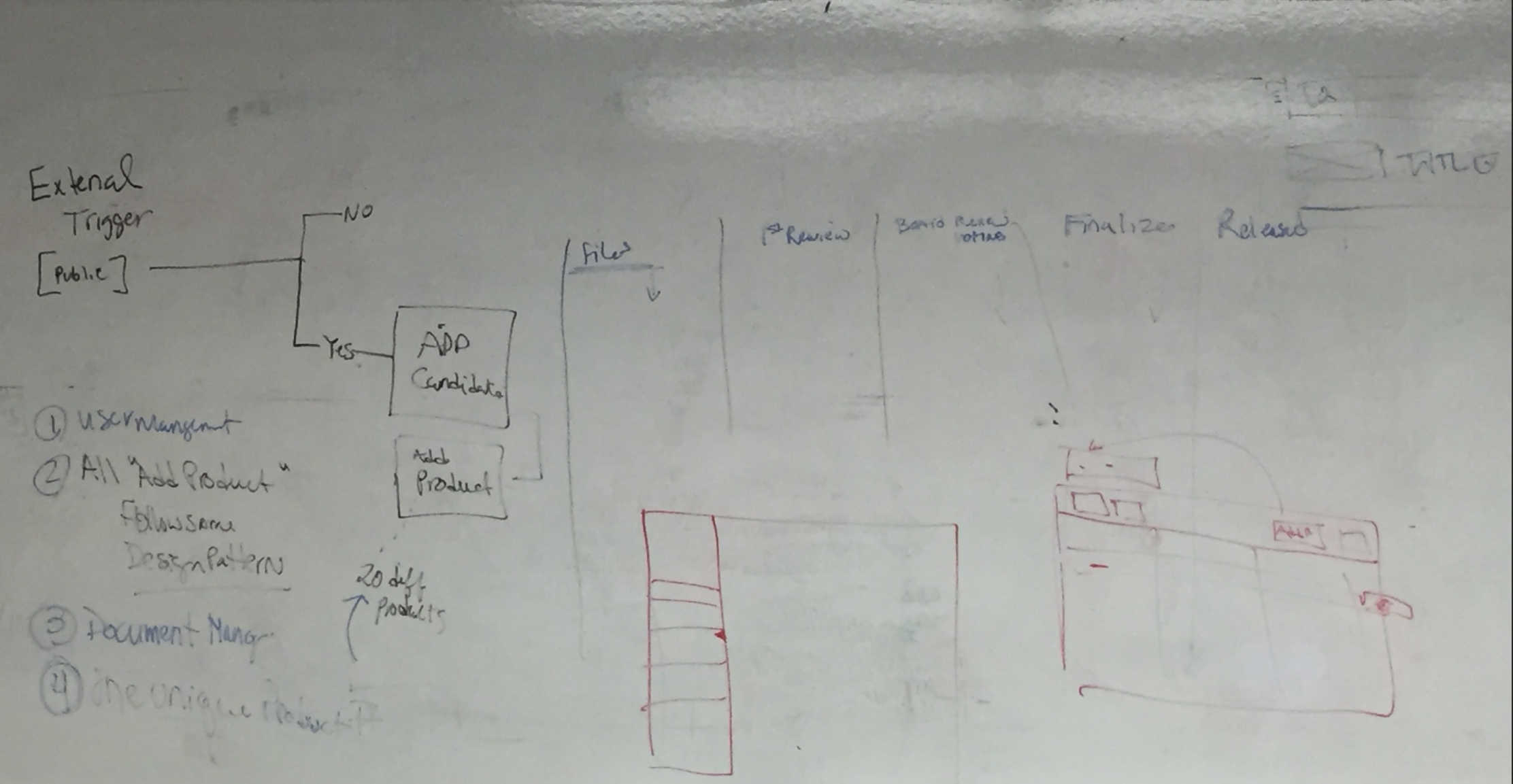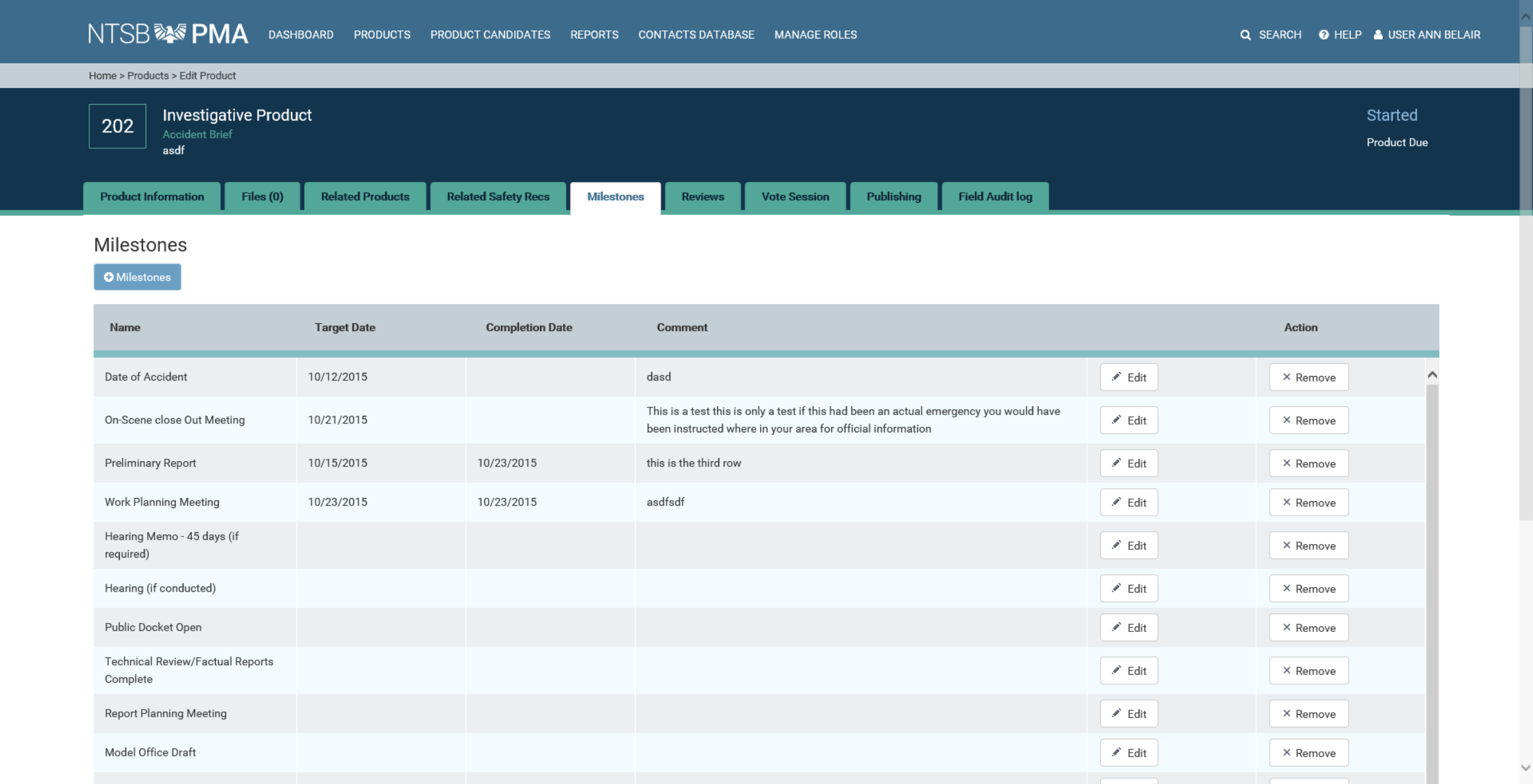
Document Management System
PMA is a collaboration tool for the National Transportation Safety Board.
OVERVIEW
The National Transportation Safety Board (NTSB) is an independent government agency. Their mission is to make transportation safer. They do this by conducting independent accident investigations and making safety recommendations.
Product Management Application (PMA) is the redesign of the NTSB's document management system. This tool helps the organization manage and process their work.
ROLES & DURATION
User Experience Designer | InfoReliance
User Research, Information architecture, User Journey Mapping, Interaction Design, Visual Design, Prototyping, & Usability Testing
Team: 1 designer, 1 product manager, 1 business analyst, 3 developers
Sept 2015 - Oct 2016
CLIENT
The problem
Restrictive tools are time-consuming and reduce productivity.
The NTSB's legacy tool was complicated. The system revolved around one department to process work, and it was not intuitive to most of the agency. Other departments created workarounds to collaborate and track their work. And despite its complexity, documents must be approved through this system.
The tool mirrored their original paper system.
THE CHALLENGE
Streamline collaboration and transparency in the workflow
Our goal for PMA was to create a flexible and collaborative document management tool. These documents, referred to as "products" within the agency, can be investigation reports, safety recommendations, or responses to shared recommendations. All products travel through at least three offices during their lifecycle. The tool needed to support the work through creation, iteration, and approval phases.
Our high-level goals were to:
Simplify business processes for document approval.
Give users more control over their workflow.
This tool was launched internally in October 2016.
Reconciling information and resources
When I joined this effort, it had been underway for 8 months (the last three without design support). The team's goals were not aligned and a lot of time was spent going back and forth on requirements. We did not have a clear understanding of user needs. I partnered with our program manager to review existing research and documentation.
THE DISCOVERY
Validating what we know and filling in what we don’t
The existing material gave us a general idea of what we were working towards, but not how to handle the agency's current challenges. A lot of what we found mirrored the agency's existing complexity. We needed to focus on understanding the workflow and where simplification was needed.
Qualitative interviews to understand the ecosystem
We needed to speak to users to understand fill in the NTSB ecosystem. We met 10 people across the agency to understand the workflow and responsibilities. Our goal was to learn about their processes, pain points, and workarounds.
Here are the responsibilities of the offices involved in creating and releasing products.
Modal Office
Offices are defined by the type of transportation they investigate. The outcomes are then summarized in a report with recommendations. The people working on these products have rotating roles: writer, editor, or reviewer. All products begin in modal offices, with the writer owning its lifecycle.
Managing Director’s Office
This office helps direct the agency's work and approval process. The Managing Director approves products for a board vote, but the staff handles the bulk. They pre-check products before they are seen by the MD. Any products that are missing information or incorrectly formatted get returned to the original office for revision. They manage the board calendar and schedule items for voting. Lastly, they release public communication and direct incoming responses to the appropriate offices.
Board of Directors
The Board consists of five members serving 5-year terms. They vote on the probable cause of the accidents and recommendations outlined in the investigative reports. If the Board agrees, reports and recommendations will be finalized and publicly released. If the Board disagrees, the products are returned to the modal offices for the next step.
Safety Recommendation Office
The SRC manages the safety recommendations created by the NTSB. They help to keep the recommendations updated, and the public informed. Currently, most of this work is handled manually by one individual.
This department is not part of the MVP.
INSIGHTS
Bringing simplicity forward
System visibility in progression
Document owners in modal offices needed to know their document's status. This was not always visible, especially for products that have been sent for approval.
Need help navigating the steps in the process
The Managing Director's Office stated that they would often receive incomplete documents. These products would need to be returned to offices for revision.
Manage my product and all corresponding tasks
Collaboration in or across offices is common. Often, writers (document owners) ask for edits or reviews on their reports. A person can concurrently have writing, editing, or reviewing responsibilities on many products.
REFRAMING THE PROBLEM
Managing disparate and unknown processes causes delays
The cognitive load for the existing process is burdensome to modal office users. This is an even heavier burden for newer employees.
There can be many steps required for each phase; these steps vary by product type. Individually tracking unclear processes and collaboration for various products leaves room for mistakes. Incomplete (or incorrect) products need to be returned and revised. This delays the release.
THE IDEATION
Simplifying the workflow
Regardless of the steps for a product, all efforts could be grouped into simplified stages. We validated the high-level stages with each department. Grouping in this manner allowed people to understand the product's progress at a glance.
This is the workflow after an investigation concludes.
THE REDESIGN
Elevating visibility and action
The insights helped us define the goal of creating a tool that emphasized transparency and guidance.
With each product following different steps, PMA helps to guide the agency through each approval process. PMA provides instruction and transparency for each phase and the next steps. It answers the most significant pain point for most users, "Where am I and what do I need to do next?"
Note: The MVP scope included insights learned from modal offices, the Managing Director, and the Board. The SRC workflow was not part of this release.
System visibility and clear guidance on next steps
Each product goes through different approval steps. We cannot expect writers/document owners to memorize these for each product they work on. We aimed to:
Provide transparency for all user levels about the status and progress of work.
Guidance for each product.
Insights into agency progress and workload
Most of the agency simultaneously works on many varying complexity products. They need to track overall progress as well as have quick access to individual details. We opted to present a dashboard that highlighted:
What I need to work on and what products I am responsible for.
What products my office is responsible for.
Open requests to my office (by other offices).
THE OUTCOME
Building trust step by step
The overall agency response was positive. PMA increased product status visibility for modal offices, something they had been missing. The guidance allowed users to trust the process and the next steps. Throughout testing, offices helped us confirm the product workflow and usability. During the pilot launch, users navigated their product through the phases without help.
THE LEARNINGS
Adopting changes beyond the rules
Early on, we learned that removing steps would need Board approval. This could not happen within our timeframe. So, we opted to provide simplified but meaningful information at a glance. We wanted to bring transparency, guidance, and flexibility forward.
We had support from the majority of the agency, but we still encountered some resistance. While people did want to improve efficiency, they also wanted security in their roles. The new system is designed to be less dependent on individuals. New job responsibilities were not clearly communicated; transparency is essential to long-term success. Changes should be openly discussed with the people they will affect before beginning.
Next steps
The NTSB is continuing its journey towards simplification. Based on feedback, priorities include:
wizard-like guidance
templates to standardize documents
onboarding the SRC manual work





